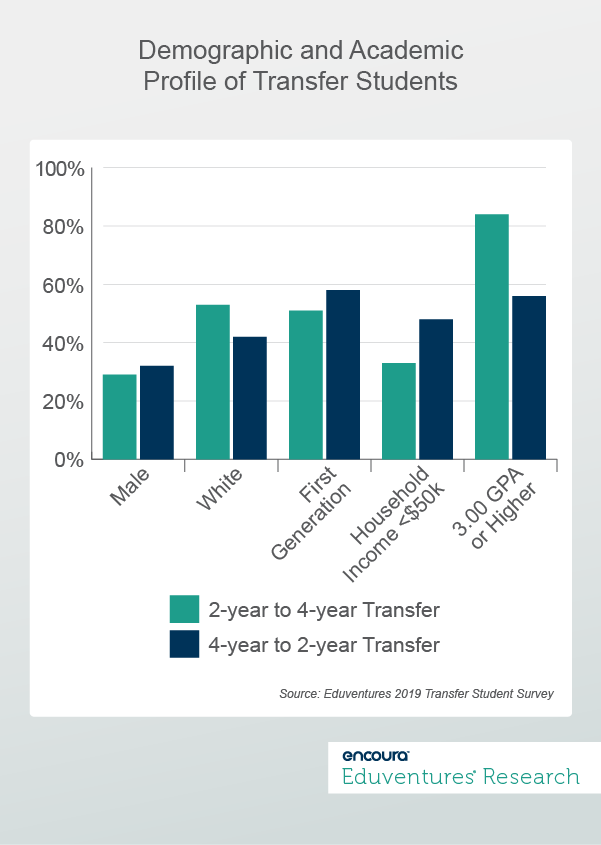When we think of transfer students, we often think about the cost-sensitive community college student looking to finish at a four-year school. There is, however, another group of transfer students institutions should pay attention to, particularly if they are concerned about retention: Reverse transfer students. Those who start at a four-year college and transfer to a two-year school.
This “reverse transfer student” group represents 18% of respondents in our most recent Transfer Student Survey™.
It’s all About Cost (Or Is It?)
Let’s start by examining the motivations for the transfer. Are reverse transfer students driven by fundamentally different motivations than students who have chosen a more traditional transfer path?
Table 1 shows the top three reasons for the transfer and the top three priorities for the transfer school for students who transferred from a two-year to a four-year school (vertical transfer), and those who transferred from a four-year to a two-year school (reverse transfer).
Table 1. Top Three Priorities Students have for their Transfer School
| 2-year to 4-year Transfer | 4-year to 2-year Transfer | |
|---|---|---|
| Top 3 Reasons for Transfer | Always planned on transferring (74%) Wanted a better school (24%) Didn’t have major (18%) | Too expensive (48%) Not a good fit (38%) Personal circumstances changed (34%) |
| Top 3 Priorities for Transfer School | Majors availability (52%) Credits would transfer (48%) Cost of tuition (42%) | Cost of tuition (62%) Financial aid available (37%) Majors availability (36%) |
Source: Eduventures 2019 Transfer Student Survey
We can see that reverse transfer students cite cost as a key motivator. Forty-eight percent of four-year to two-year transfer students thought their original schools were too expensive, a reason that does not emerge among the top three for students who transfer from a two-year to a four-year school.
Sixty-two percent of reverse transfer students also say that cost was a key factor when considering transfer schools (62%). While cost also plays an important role for vertical transfer students (42%), reverse transfers cite this factor much more frequently.
Why did the reverse transfer students choose a four-year school that they could not afford to attend after all? Demographic and academic information provide clues about the socioeconomic background of these students (Figure 1).

We see that reverse transfer students are more likely to be non-white, report lower household incomes, and are more likely to be first-generation students than vertical transfer students. Cost matters, and they may have had less family support in navigating the financial aid process.
What is really interesting, however, is that reverse transfer students also seem to struggle academically more than their peers. Only 56% report a GPA of 3.0 or higher, compared to 84% of two-year to four-year transfers. This conjures the image of a student juggling coursework with a much-needed job, and subsequently struggling to keep up academically. Is this true?
Pulling the Purse Strings
To find out whether these reverse transfer students are truly on their own financially, we examine in Figure 2 what transfer students told us about their parents’ financial contributions to their educations.

Contrary to our previous hypothesis, we see that students who transferred from a four-year school to a two-year school are actually quite likely to depend entirely on parental support (35%), and quite unlikely to be responsible for financing their educations on their own (12%). Given their lower academic performance, we can just imagine that these parents—supporting their children despite less financial means—may also be less willing to pay the high cost of a four-year degree when the student performs below their expectations.
From an early age, most students (and their families) receive the message that higher education is a necessary goal, but not all are academically and emotionally prepared to enter college right after high school. This can be a costly lesson to learn.
The Bottom Line
So, why did these students enroll in a four-year program in the first place if it wasn’t a good fit? Is this really just a family issue, or are high schools and colleges also pushing too hard for four-year credentials without offering viable alternatives?
In this highly competitive enrollment environment, many institutions are understandably concerned with making their classes. But it’s equally important to consider the right-fit students. Enrollment management is often treated like a sprint, but it should be a marathon. The question “will they come?” should be immediately followed by “will they stay?” and “will they graduate?”
We are just beginning to uncover the experiences of students who have already transferred. Stay connected to learn more about this student population in upcoming reports, webinars, and conference presentations.

Never
Miss Your
Wake-Up Call
Learn more about our team of expert research analysts here.
Eduventures Senior Analyst at ACT | NRCCUA
Contact
Thursday, February 20, 2020 at 2PM ET/1PM CT
Research on your admitted students can provide enrollment leaders insight into why students enrolled in their institution -- and perhaps more importantly, why they didn’t -- but without benchmarks, an institution can only understand its result in isolation.
Inevitably, an institution is compelled to ask: How does its admitted student metrics look in comparison to other institutions in its category. Using data from the Survey of Admitted Students™, our latest benchmark report outlines the nine key benchmarks that every college and university can use to inform recruitment, yield, and institutional identity.
In this webinar, Eduventures Principal Analyst Kim Reid will identify key strategic questions every enrollment leader should be asking to measure up the institution’s yield performance and how to take specific action to improve your class.

